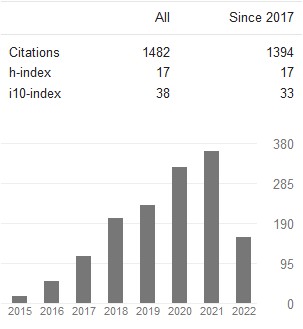Improvement of thermophilic α-amylase productivity through UV mutagenesis and AmyE gene amplification and sequencing
Abstract
Induction of mutation with UV was used to improve α-amylase enzyme production by Bacillus licheniformis MK90, an Egyptian isolate. One hundred eighty mutants were isolated after UV treatment for 3, 5, 7 and 10 min. Three mutants (UV-5-M3, UV-3-M17, and UV-5-M121) were higher α-amylase producers than parental strain and mutant UV-5-M121 was the highest producer one with 150.8% of WT productivity. Parental α-amylase has molecular weight equal 64 kDa while it was 65 kDa with UV-5-mutant 121 and 61 kDa with UV-5-mutant 3 through SDS-PAGE analysis. SDS-PAGE showed a high variance between the two mutants and WT, mutant UV-M3 showed 15 bands, UV-M121 showed 17 bands, while WT showed 18 bands. The best two producer mutants UV-5-m121 and UV-5-m3 proved its maximum production after 72h of fermentation at temperature 55 and 65°C with pH 7 and 8. Starch at 1.5% was the best concentration for the most mutants to reach their maximum productivity after 72h of fermentation. AmyE gene was amplified, and sequenced. It was 1539 bps in the three sequences. Mutant UV-5-m1 21 contains the lowest nucleotide substitution sites; it reached 5 only. While mutant UV-5-m3 contains seven substitutions compared with the parental sequence
Keywords:
Bacillus licheniformis, α-amylase, AmyE gene, UV mutation, Genomic environmental interactionDownloads
Published
How to Cite
Issue
Section
Copyright (c) 2017 Khedr M.A., Emad A. Ewais, Khalil K. M. A.

This work is licensed under a Creative Commons Attribution-NonCommercial-ShareAlike 4.0 International License.



 Journal of Innovations in Pharmaceutical and Biological Sciences is licensed under a Creative Commons Attribution-NonCommercial-ShareAlike 4.0 International License. Based on a work at
Journal of Innovations in Pharmaceutical and Biological Sciences is licensed under a Creative Commons Attribution-NonCommercial-ShareAlike 4.0 International License. Based on a work at